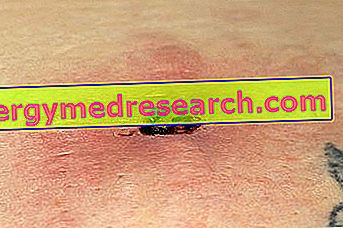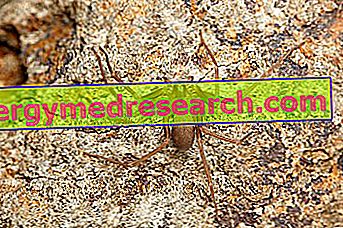Generality
The violin spider bite is generally painless but, in some cases, it can be extremely dangerous .

If in some circumstances the bite does not cause any particular damage, in other situations, the attack of this small spider can lead to the appearance of very serious consequences.
For this reason, the violin spider bite - as well as the bite of any other spider - should not be underestimated, even when apparently no symptoms of any kind appear. The symptomatology, in fact, can appear even a few hours after the bite has taken place. Clearly, to be sure that it is the bite of a violin spider it would be appropriate to be able to see the arachnid during the attack and be able to identify it or capture it. Unfortunately, however, this is not always possible and the diagnosis is made exclusively on the basis of the visual evaluation of the skin lesion and on the analysis of the symptoms presented and described by the patient.
Due to the consequences of its bite, in Italy the violin spider is considered - together with the Mediterranean black malmignatta or widow - a species of medical relevance to humans .
What is that
What is the Violin Spider and Why Bites?
The violin spider is an arachnid belonging to the Sicariidae family, genus Loxosceles specie rufescens . It is a small spider whose body does not exceed 9 millimeters in size. Taking into consideration also the legs, the dimensions increase up to a maximum of 4-5 centimeters.
The violin spider is a predominantly nocturnal animal that comes out of its hole in the dark hours to hunt or to go in search of the female in the case of the male specimen. It is a spider with a shy behavior and a NOT aggressive nature that, in front of a human being, prefers to flee rather than attack. The violin spider bite, therefore, is not so frequent, but occurs accidentally . In fact, this spider attacks only to defend itself if it feels threatened and finds no escape route.
Unfortunately, it can happen that the spider takes refuge in the house and hides inside small cracks in the wall, among the stones, behind the skirting boards, under furniture or boxes, or inside shoes or clothes or household linen, such as gloves, socks, sheets, etc. In such situations, the bite is a decidedly more probable event since if one does not realize the presence of this "guest", handling the objects in which he has taken refuge, the animal may feel attacked, with no way out and would be, therefore, driven to attack.
Symptoms
Symptoms Induced by Violin Spider Bite
Usually, the violin spider bite is not immediately perceived and the first symptoms appear after a few hours. Fortunately, the symptoms are not always severe and potentially lethal, but can also occur in a mild form.
However, the symptoms resulting from the violin spider bite are caused by the inoculation of the cytotoxic secretion (poison) through the poisonous spines of which the animal is equipped. Depending on the amount of poison inoculated with the bite, the individual may experience different, more or less severe symptoms.
Although initially the violin spider bite is not perceived in any way, pain is a symptom that always appears, generally 30-60 minutes after the attack. The painful stimulus can occur locally, at the point where the spider has bitten, as well as can extend to the entire limb (in the case of bites on hands, feet, arms and legs) or to the surrounding areas.
Symptoms of Slight Entity
In milder cases, usually, symptoms similar to those induced by bites or insect bites or other arachnids occur alongside pain. Among these symptoms, we recall:
- Irritation;
- Redness;
- Swelling;
- Appearance of erythemas;
- Burning and tingling;
- Itch.
Even if the symptoms are not particularly serious, it should be pointed out that the violin spider bite can give rise to a skin lesion that is difficult to resolve and which takes a long time to heal.
Symptoms of Severe Entity
In the most serious cases - fortunately not very widespread - on the other hand, far more severe symptoms can occur not only on the site where the spider has bitten the individual, but also on a systemic level.

In this case, we speak more properly of loxoscelismo, a syndrome that manifests itself at the skin and systemic level induced precisely by the poison of the spider. The first symptoms of loxoscelismo may appear as early as 10-20 minutes after the bite occurred.
The skin symptoms manifested in such cases are characterized by the appearance of:
- Burning type pain;
- Swelling and redness;
- Itch;
- Burning and tingling;
- Decreased sensitivity in the affected area.
After a few hours, at the site where the violin spider gave the bite, a vesicle appears surrounded by an area of livid or whitish skin in turn surrounded by an area of erythematous skin . Sometimes, the aforementioned bladder breaks, thus causing an ulcer, which leads to the formation of an eschar (necrotic lesion).
At the systemic level, however, the loxoscelismo is characterized by the appearance of:
- High fever;
- Nausea and vomit;
- Chills;
- Myalgia and arthralgia;
- Headache;
- Hemolysis and thrombocytopenia.
In the most serious cases, moreover, the loxoscelismo can lead to the appearance of: cardiac arrhythmias, renal insufficiency, hypertensive crises, confusion, loss of consciousness, coma and death.
Did you know that ...
The violin spider bite causes serious effects especially in subjects already debilitated for other reasons (presence of previous pathologies) and in subjects particularly sensitive to the venom injected with the bite.
However, it is necessary to specify that the spider does not always inject its poison when it bites.
To learn more: Loxoscelismo »Complications
Complications of the Violin Spider Bite
Among the main complications of the violin spider bite we find without a doubt the secondary infection of the resulting lesion. The microorganisms responsible for the infection in question can be carried by the spider itself, as well as can reach and infect the lesion at a later time.
Among the possible complications of loxoscelismo, however, we recall: haemolytic anemia, disseminated intravascular coagulopathy, myonecrosis, rhabdomyolysis, coma and death. Fortunately, these complications seem to occur rather rarely.
Allergic reactions
In previously sensitized subjects, allergic reactions can occur, sometimes severe, characterized by both local and systemic manifestations . In extremely severe cases, anaphylactic shock may also occur .
Diagnosis
How to diagnose a Violin Spider Bite?
In order to ensure proper treatment of the violin spider bite, it is very important to make a correct diagnosis .
Since the bite of this spider is not painful, more often than not, one notices the attack only when the animal has already fled or in any case when it is no longer visible, thus making identification difficult. of the person responsible for the bite.
The diagnosis, therefore, is essentially based on the visual analysis of the skin lesion presented by the patient and on the analysis of the symptoms manifested by it. In this regard, we recall that, in the evaluation of the patient, it is very important to exclude the presence of other disorders whose symptoms may mimic or be similar to those caused by the violin spider bite. Among these, we find: the bites or stings of other animals, some skin diseases, some types of skin infections and systemic infections, injuries caused by burns, etc.
Care and Treatment
Violin Spider Bite Treatments and Treatments
The treatment and treatment of the violin spider bite may be different depending on the case. Generally speaking, if you are certain that you have been bitten by a spider, you should immediately contact the medical help (call 118) and possibly a poison control center whose doctors will be able to give comprehensive information on how to behave. In fact, even if the violin spider bite is often not too severe, in no case should it be underestimated.
First Intervention in the Case of Violin Spider Bite
If you realize that you have been bitten by a violin spider - after alerting your doctor or health workers - it can be useful:
- Wash the wound thoroughly with soap and water;
- Avoid applying aggressive disinfectants;
- Compress the vice area and - if limbs are involved - keep them raised;
- Avoid manipulating or engraving the site where the bite is present;
- Pay attention to the appearance of symptoms of any kind, taking care to monitor the evolution of the skin lesion.
If symptoms persist or worsen, the doctor may decide to proceed with medication.
Injury treatment caused by the Violin Spider Bite
Regardless of the severity of the symptoms induced by the violin spider bite, the resulting skin lesion must be regularly cleaned and bandaged, preferably every day. These operations can be performed by the patient in his own home in milder cases; while they may require medical attention in the most serious cases and if you are in the presence of loxoscelism (formation of vesicle, ulcer and eschar).
In any case, even when the skin lesion resulting from the violin spider bite is slight, it is advisable to ask the doctor for advice on how to take care of the wound.
Drugs used in the case of Violin Spider Bite
In addition to the constant care of the skin lesion, the doctor could prescribe the administration of drugs by topical or oral way, in order to reduce pain ( analgesic drugs, even opioids) and inflammation ( corticosteroid drugs, generally in the form of ointments to be applied locally ). Sometimes, the doctor may also consider it necessary to administer antihistamine drugs to reduce the amount of urticarial-type skin manifestations that may appear. Finally, to prevent or treat any infections, it is possible for the doctor to prescribe antibiotic- based therapy.
Hospitalization
In the event of loxoscelism and systemic symptoms, the patient is usually admitted to the hospital, where he will receive the necessary treatment and supportive care.
Surgical treatment
The surgical treatment of the violin spider bite is carried out in the most severe cases to remove the necrotic area that has formed. However, surgical resection can only be performed when the necrotic lesion is completely enclosed. Unfortunately, however, this process can take several weeks, during which time the lesion must still be treated daily.
Furthermore, it should be remembered that, in particularly serious cases, after surgical resection of the necrotic lesion, it may be necessary to intervene with reconstructive plastic surgery treatments.
Prevention
How to Prevent Violin Spider Bite
The violin spider is an animal that has always been present in Italy and can therefore be considered as a native species . In particular, it is widespread in Mediterranean areas and lives mainly in places where it can protect itself from the external environment, such as cracks in walls, cracks, wood, warehouses, garages, old houses, but also inhabited houses where he can find hiding places to take refuge in (behind the skirting boards, under the furniture, in the middle of clothes, etc.).
As mentioned, during the day, the violin spider prefers to remain safe in its lair to leave it only during night hours to hunt for prey or to mate. The encounter of man with this spider, therefore, is generally accidental. In any case, the violin spider is not aggressive and prefers the escape to the attack; nevertheless, if he feels threatened, he can react by biting the unfortunate victim. To prevent this, it may be useful:
- Wear protective clothing when carrying out activities at risk that could favor the encounter with the violin spider (for example, reorganization of warehouses or environments in which there are cracks in the walls and possible hiding places; gardening; cutting and tidying of wood; etc.) ;
- Use extreme caution when removing spider webs or spiders' burrows ;
- Do not handle violin spiders with bare hands . In fact, even if you don't intend to hurt them, spiders may feel threatened and attack by biting. Therefore, to remove them or move them away from the house or other places, it is best to avoid direct contact and use, for example, broom and dustpan. In this way, the risk of violin spider bite is avoided and, at the same time, the animal's life is spared.
How to Recognize a Violin Spider
The violin spider - scientific name Loxosceles rufescens - is a small spider of yellowish-brown color . Its body reaches a maximum of 9 millimeters in length; taking into consideration even the long legs, the maximum size of this spider is around 4-5 centimeters .

Given the size is not too high and the color is certainly not showy, together with the shy and purely nocturnal behavior, the violin spider often goes unnoticed and is hardly identified at a quick glance. However, it has a peculiarity that allows it to be easily distinguished from other types of spiders. In fact, on the cephalothorax (the front part of the body, where the eyes are also located, so to speak), it has a dark colored spot whose shape resembles that of a violin whose handle (a straight line) continues on to the abdomen the animal. As one can easily guess, it is from this spot that the common name with which L. rufescens is known derives.
In the event of a spider attack, therefore, the observation of the aforementioned characteristic (if possible) can be useful to understand immediately if one has been so unlucky as to experience the violin spider bite.



